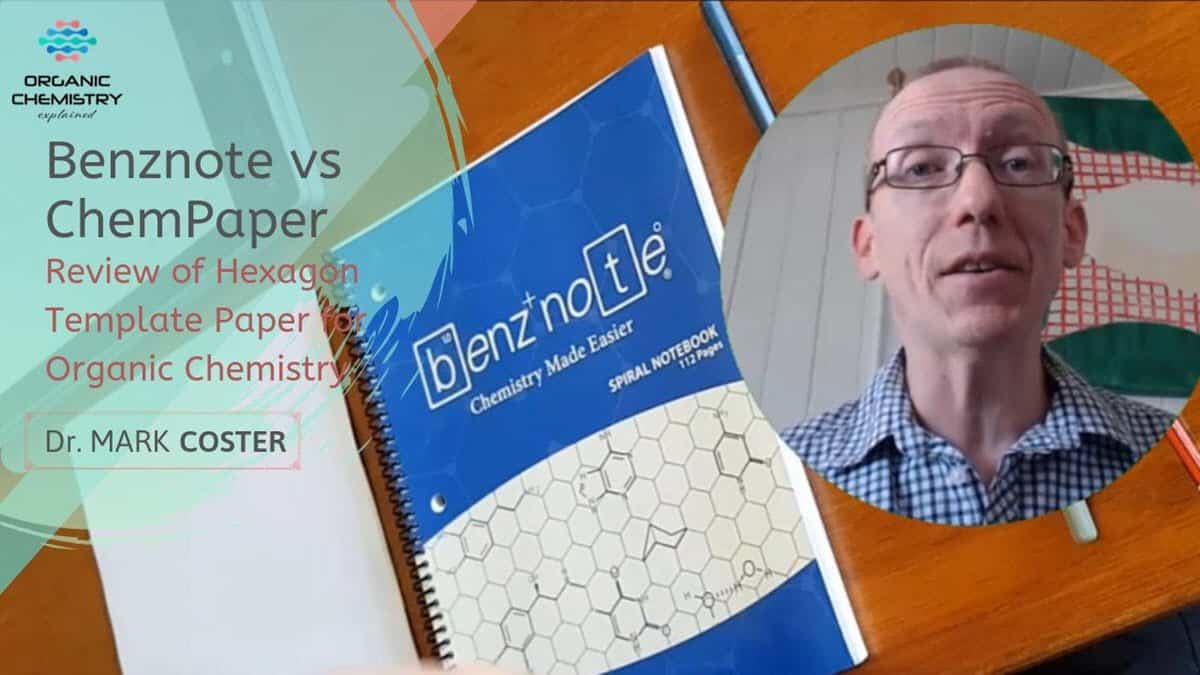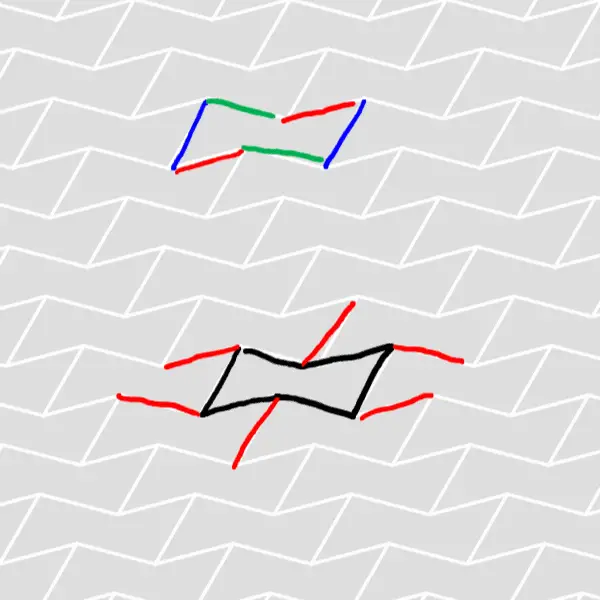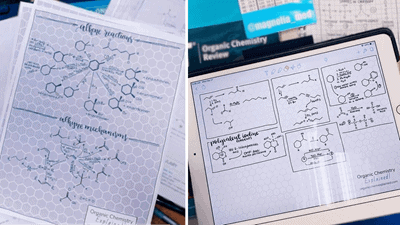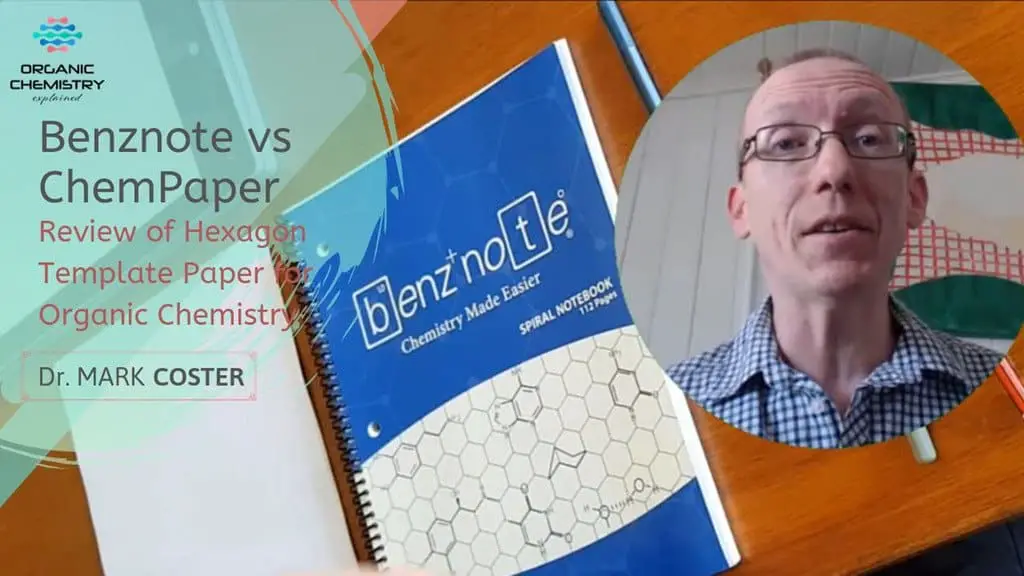Benznote vs ChemPaper – Review of Hexagon Template Paper for Organic Chemistry
How to Draw Neat Organic Chemistry Structures? There’s a lot of students that I talk to who are interested in hexagon graph paper as templates that will help them draw better organic chemistry shapes. Particularly hexagons like for benzene or chair cyclohexanes when you get to chair conformations.
There are two options: 1) Benznote – available online from Amazon. It’s a spiral bound notebook that has hexagon grid paper. Or, 2) an option that I’ve developed, called ChemPaper. My ChemPaper is a set of structure drawing templates in a variety of formats, available from here on my website. I’ll look at each of these in turn.
Let’s start with Benznote. As I’ve said, it’s spiral bound. It has 112 pages and it’s in letter format. It’s for chemistry made easier (as printed on the cover).
The thing about Benznote is that it is a faint green template. I guess that’s to provide a good contrast on what you draw in either a black or blue pen. It also has three-hole punches and there’s a tear out perforation along the edge of it.
Now, I’ve got a couple of pencils here. I got a fairly blunt 2B pencil so here (see video above), I’ll just draw out a structure so you can see what it looks like. Now, I don’t have any artificial lights here. This is just natural light coming in from the window. The drawings do stand out fairly well against that green background. And certainly, I am not the neatest organic chemist. I can use a little bit of practice with a template like this. Let’s do a Clemmensen reduction. Make that go down to this and do zinc and HCI and so on. There’s more you can do with a hexagonal template than just draw benzene structures. You can draw your zigzag or bond-line structures or line-bond structures. You can draw non-benzenoid but six-membered rings. Now, when you get to smaller ring sizes like five then you have to avoid the template to some extent, but I do find that the template at least gives you an indication of where you might need to go inside that hexagonal shape.
Now, we can also use a hexagonal template for doing things like a Newman projection. In a Newman projection, you can start off with your three lines, put your substituents, and you put a circle in the middle. Then what you want to do is get your lines going out to each of these points here for the other three possibilities. So that’s what I recommend. Use one of these templates for hexagonal shapes like benzenes or cyclohexanes. You can draw other ring systems, zigzag or line-bond structures. You can draw branching, draw rings attached to that, draw other ring sizes, that’s not a problem.
But what I don’t recommend you do is draw your cyclohexane chairs. A cyclohexane chair looks like this (refer to the video). That’s not supposed to fit into a hexagonal template I must say, I was a bit shocked and a little bit disappointed to see on the front cover of Benznote one of the exemplar structure’s being a chair cyclohexane.
Don’t do that. That’s a horrible chair cyclohexane and just looks ugly. Your professor’s not going to like that if they see it in an exam. Also, there’s some odd things in the front here. This oxygen that’s really super-big compared to the other hydrogen and so on. A lot of structures you see online and in real life, these are not great organic chemistry structures that are used in this example.
If you would like to have a hard copy, a notebook that has a hexagonal template for drawing your structures or your notes for your organic chemistry lectures, then I think Benznote is a good option and particularly if you like a spiral bound or if you like perforated pages with these hole punches.
When I made templates for organic chemistry structure drawing, I decided not to do hard copies like this because I didn’t want to have the hassle of having to sort out the logistics of supplying a physical product and so on. So for ChemPaper, I’ve not done the hard copy. What I’ve done is I made PDF templates available. Now, what happens if you buy ChemPaper? You get a set of PDF documents in three different sizes: large, medium and small. You get sizes that fit your handwriting, and you get them in landscape and portrait.
So overall, you get six different PDF files with those three different sizes, both portrait and landscape. Each PDF document has a variety of different styles of template. There’s a regular template like this with the six-membered ring template here. I can draw my structures just as with Benznote. You can print out my PDFs as many times as you like. I can use them as a loose leaf version of a Benznote. You can use this for a Newman projection as well, and so on.
But the thing is, with my templates, I don’t just have the regular grey lines on a white background. I’ve also got a grey background with white lines. It’s a little bit similar to the white lines paper that is very popular with some people. You might prefer one over the other in terms of contrast. I quite like this grey background with the white lines. We can draw our structures from that.
As well as the grey lines and the white lines, in the hexagonal template, there’s also the chair cyclohexane. All these are printed out in the large format. There’s a small and a medium if you like to draw things on those sizes. Here’s a blue pen drawing out your chair cyclohexane. I think chair cyclohexane is something that a lot of students struggle to draw neatly when taking organic chemistry. They are really important to get right.
One thing that I would like to point out is that the chair cyclohexane template is not just good for the chair cyclohexane itself but also for putting in your substituents. So your equatorial substituents always follow one of these bonds that are part of the template and then your axial substituents will always be vertical. They will be vertical going away from the vertex where two lines meet. That lets you practice not only chair cyclohexanes but also axial and equatorial substituents. There’s a grey lines version of that as well. There’s two different versions of the chair cyclohexane because there’s two different orientations that we can draw that cyclohexane.
Actually, what a lot of students like to do is use these electronically. Because they are given to you as a PDF file, you can use them electronically. A very popular way with many students is to use them with iPad with an Apple pencil. Now, I don’t have an iPad or an Apple pencil. However, most of the students who have used ChemPaper use Notability. You can import into it any PDF you like so you can take in the PDF ChemPaper and then you can just start annotating it with the Notability app. I use a Microsoft Surface Book. It’s a Surface Book with a Stylus. This is very similar to what you can do in the Apple iPad plus an Apple pencil You can just annotate directly onto the template. Most of these annotation apps let you use colors. Or if you want to, you can draw out things like mechanisms. So we can draw out a mechanism and use the colors to show how it works.
So there’s your options.
The ChemPaper that I’ve made is available at a flat price. And again, you get all six of those PDFs, both the landscape and the portrait in all sizes – large medium and small – depending on your handwriting. You can print them out, you can use them electronically in any tablet like a Windows Surface Book or Surface Pro or with Apple products like the iPad with Apple pencil.
I hope you find this useful as a couple of options for helping you draw really nice organic chemistry structures. They are structures that are going to get you the best marks in your exam because your professor will be able to read them and see what you’re trying to tell him or her.
Good luck with your studies!








